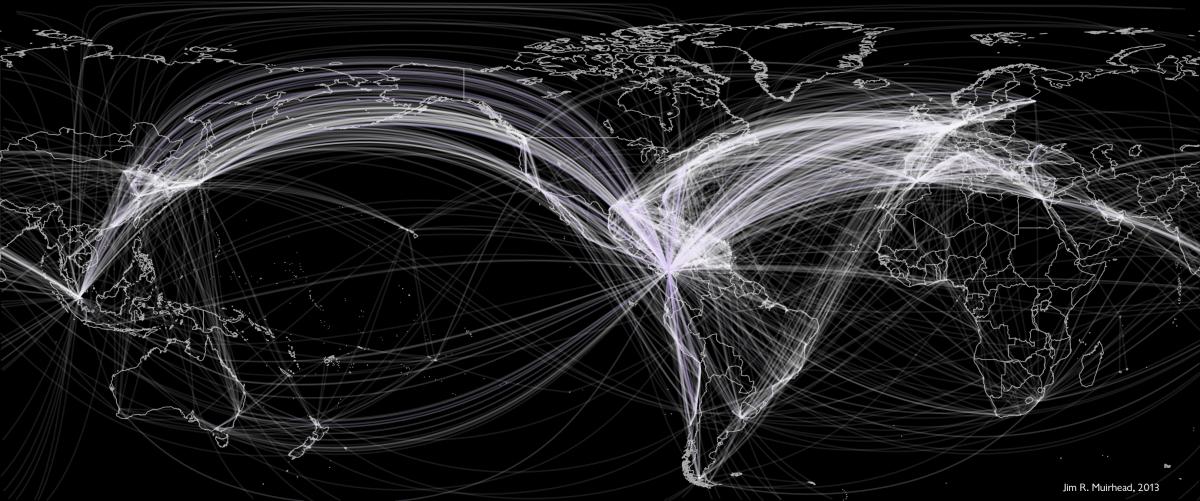The Panama Canal is turning 100 years old this year. In 1914, the first ship, the SS Ancon, passed through the Panama Canal marking a huge shift in global shipping patterns and the end of a 34-year construction endeavor between the French and Americans. The opening of the canal greatly reduced the transit time for ships going between ports in the Atlantic and Pacific Oceans. For example, a ship traveling between the East and West Coasts of the United States would save about 8,000 nautical miles (nmi), or 15 days for a ship traveling 22 knots, by using the canal rather than going around Cape Horn. Although there would be obvious benefits from the use of the canal, its construction came at a huge cost both in terms of dollars and lives lost (details available at www.canalmuseum.com).
In addition, the opening of the canal likely increased the spread of introduced species by opening a new corridor for migration through the canal and increasing the likelihood of transport by ships. Migration between the Caribbean Sea and Pacific Ocean through the canal is theoretically possible for some species; however, the fresh water of Gatun Lake in the center of the canal blocks migration of many marine species (Cohen 2006). Shipping transported species in ballast tanks and on hulls as biofouling is one of the major ways in which marine species are introduced around the world. There are several ways, discussed below, in which the canal increases the risk of species invasions globally. Unfortunately, assessing the precise impact of the Panama Canal in terms of numbers of invasions is very difficult because the canal is but one factor of many influencing ship-based invasion risk (Ruiz et al 2006).
Construction is underway for the most recent expansion project that is scheduled to open in 2015. A third set of locks, plus widening and deepening of existing channels is expected to double the cargo capacity of the canal, allowing transits of more and larger vessels. Terms commonly used for the container ships that will be able to fit through the new expansion are New-Panamax and Post-Panamax. These are two of the seven recognized size classes of container ships based on the number of twenty-foot containers, or TEUs (twenty-foot equivalent unit), that the ship can carry. Currently Panamax vessels are the largest size class able to fit though the canal.
The expansion of the canal has prompted major infrastructure changes at eight US ports hoping to be Post-Panamax ready by the time the new sections of the canal open in 2015. In light of the canal expansion, Drs. James Muirhead, Mark Minton, Whitman Miller, and Gregory Ruiz, researchers from The Marine Invasions Lab at the Smithsonian Environmental Research Center, developed a series of scenario-based models to explore how this project could impact the transfer of invasive species to the United States. This research is published in Diversity and Distributions and is available online (Muirhead et al 2014).
There are four ways in which expansion of the Panama Canal could change species introduction patterns in the United States.
- The canal would change/shorten the voyage route of the larger Post-Panamax and New-Panamax ships. For species hitching a ride in ballast tanks, the shortened voyage may mean a higher likelihood of survival. On the other hand, for biofouling marine organisms, transit through the fresh water in the canal may decrease survival.
- As ports expand to accommodate larger ships, these Post-Panamax ships will have more choices of trade ports. The likelihood of a species surviving in a port is greater when the environmental conditions of a port are similar to its home environment, termed environmental matching. Each new port visited increases the likelihood of environmental matching between the source and recipient port.
- Increased canal capacity combined with an increase in port capacity will cause an increase in the number of ships arriving to some ports. This may result in more exposure to invasive species through ballast water discharge and hull fouling, which may increase the risk of species introduction.
- Changes in the vessel types arriving at a given port influence the likelihood of invasions. Larger ships may discharge a larger volume of ballast water because they have larger ballast tanks and more of them. Similar to number 1 above, changes in ship speed may change the residence time of organisms in the tank. Also, increases in the length of a ship’s port stay for loading or unloading operations could make it easier for hull fouling species to be introduced to a new area.
Dr. Muirhead and his colleagues developed complex models based on all available information on trade, shipping patterns, and economic projections to predict how the expansion of the canal might change species invasion rates in the United States. The models used two scenarios projected out for five years. The first scenario forecasts changes in the amount of shipping traffic from the western Pacific arriving at U.S. ports based on global fleet expansion, while the second scenario models this increase in shipping traffic plus a diversion of traffic from the western Pacific to the U.S. West Coast through the canal arriving directly at ports in the Gulf of Mexico and East Coast. These models predicted that the Gulf of Mexico will receive 2.7 times more wetted surface area over the five year period if shipping traffic is diverted through the canal. The wetted surface area is a measure of the part of a ship’s hull that is under the water. This is the area of a ship that can be covered with biofouling (see the November 2012 feature Story on fouling of commercial ships). In addition, the Gulf of Mexico would receive 2.3 times the volume of ballast water discharge. They also found that many ports on the Gulf and East Coasts would receive at least three times the number of vessel arrivals leading to increased ballast water discharge and exposure to hull fouling.

Ship-mediated transport of invasive species and the subsequent invasion of nonnative species is a complex issue influenced by many factors, many of which are unmeasurable. For example, at this point we can estimate the amount of hull fouling on commercial vessels based on research dives, but we cannot measure it on all incoming ships or predict which fouling species will produce offspring that survive in a given port. But we do know that with greater exposure to nonnative species comes an increased risk of invasion. So while the expansion of the Panama Canal may be economically advantageous for some regions of the country, it is not without risks or costs.
References
Cohen, AN. 2006. Species introductions and the Panama Canal. In Gollasch, S, BS Galil and AN Cohen (eds) Bridging divides: maritime canals as invasion corridors. Series: Monographiae Biologicae, Vol. 83. Springer. Pgs 127-206
Muirhead, JR, MS Minton, WA Miller, and GM Ruiz. 2014. Projected effects of the Panama Canal expansion on shipping traffic and biological invasions. Diversity and Distributions. doi: 10.1111/ddi.12260
Ruiz, GM, J Lorda, A Arnwine, and K Lion. 2006. Shipping Patterns Associated with the Panama Canal: Effects on Biotic Exchange? In Gollasch, S, BS Galil and AN Cohen (eds) Bridging divides: maritime canals as invasion corridors. Series: Monographiae Biologicae, Vol. 83. Springer. Pgs 113-126






